Constituting a distinctive part of the regal Alpine range, which majestically situates itself within French borders, the French Alps are nestled in the illustrious regions of Auvergne-Rhône-Alpes and Provence-Alpes-Côte d’Azur. Portions of these Alpine ranges, including the formidable Mont Blanc massif, spread their grandeur beyond France, extending into the neighbouring nations of Switzerland and Italy.
Towering at an impressive height of 4,808 metres, Mont Blanc or Monte Bianco, stationed along the Italy-France boundary, reigns as the apex of the mighty Alps and the loftiest peak in Western Europe.
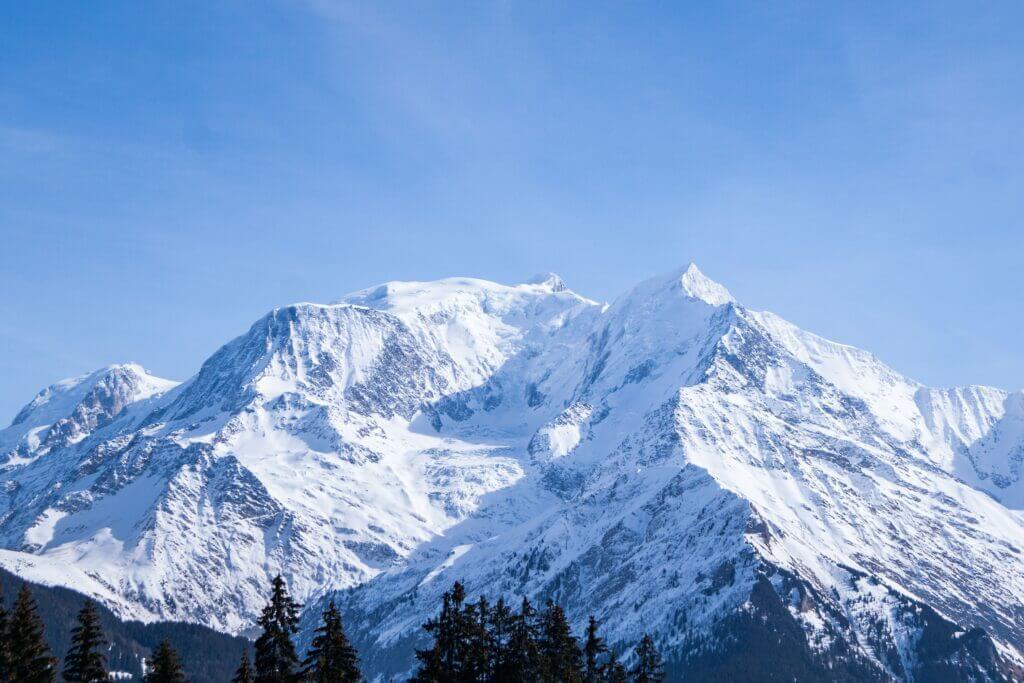
Foremost towns dotting the landscape of the French Alps include the likes of Grenoble, Chamonix, Annecy, Chambéry, Évian-les-Bains and Albertville.
The Alps, as the principal mountain range in Europe, stand imposing among the world’s longest and loftiest ranges, extending over 700 miles across a total of eight countries. With Mont Blanc positioned near France’s borders with Italy and Switzerland, this region, supplemented by its adjacency to Lake Geneva, offers some of the most visually pleasing ski resorts, alpine villages and holiday prospects worldwide.
While not a prerequisite for tourist pleasure, skiing forms an integral facet of the inherent culture of the French Alps, supplemented by the après-ski tradition, or the ‘after-ski’, an experience which ensues once the skis are removed. Summer seasons herald the iconic Tour de France, a celebrated men’s cycling event that winds its way through the Alps. Visitors can indulge in the curative properties of natural hot springs, post a day filled with skiing escapades, cable car journeys, or simply luxuriating in the Alpine splendour. Slide into your ski bindings, pack your hiking boots and head towards these remarkable destinations in the idyllic French Alps, a premier choice amongst holiday locations throughout France.
Chamonix: The Heart of Alpine Adventure in the French Alps
In 1924, the inaugural Winter Olympics took place in Chamonix-Mont-Blanc, a town more colloquially known as Chamonix. Nestled within the heart of France’s Haute-Savoie department, a subdivision within the larger context of the Auvergne-Rhône-Alpes region, it parallels the arrangement of counties within US states. A century on, this picturesque corner of southeastern France, hemmed by Italy and Switzerland, still attracts a global allegiance of visitors seeking the crème de la crème of skiing or merely to marvel at its snowy vistas.
Locating the country’s loftiest cable car in Chamonix at the peak of the Aiguille du Midi Mountain is no mean feat. Intrepid skiers and those possessing just the courage alone will ascend more than 12,600 feet to the starting point of the Vallée Blanche. This “off-piste” region of the French Alps, where the slopes remain untouched and unprepared for skiing, unfurls opportunities for glacial skiing and astronomical viewpoints nestled at the foot of the Mont Blanc massif mountain range.
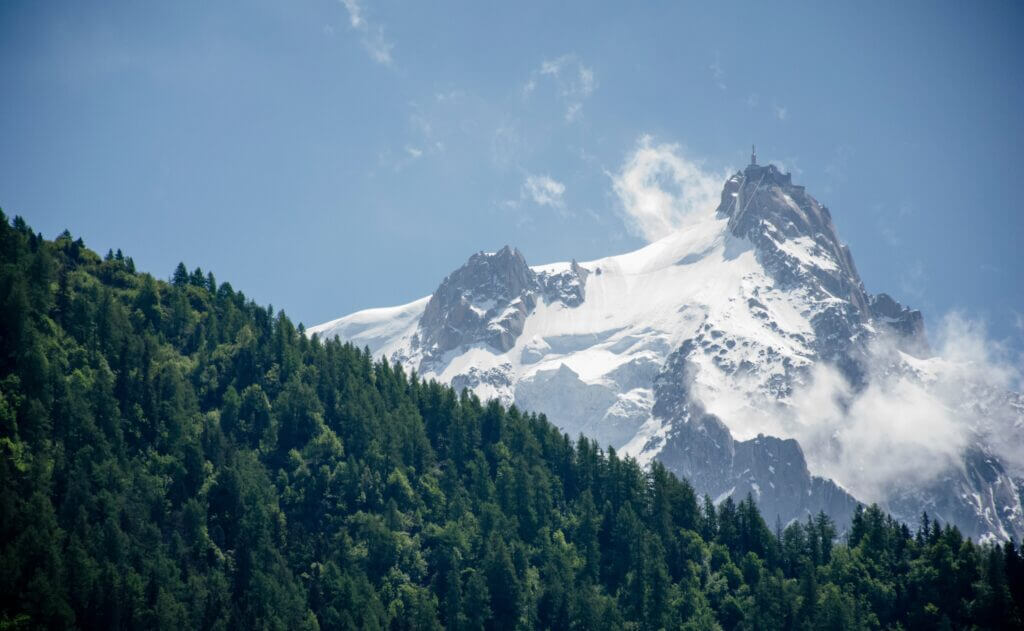
A rail journey best suited for those adverse to skiing endeavours lies with the Montenvers-Mer de Glace train. This delightful cherry-hued cogwheel train ferries passengers from Chamonix to Montenvers, enabling visitors to access the Mer de Glace, France’s largest glacier. An exploration of an ice cave nestled within the glacier awaits, offering insight into its historical and environmental narratives amidst the realities of climate change. Once their curiosity is sated, visitors can retreat to the warmth of the Refuge du Montenvers restaurant for a traditional meal before journeying back to Chamonix.
The hamlet of Chamonix sits serenely in the Chamonix Valley at the foot of Mont Blanc, the Alpine’s highest peak, formidable in its 4,807-metre snow-covered glory, even during the throes of summer.
The village’s distinct high-mountain persona invites a global assortment of tourists, attracted to its stunning alpine vistas and the prospects of engaging in a myriad of outdoor pursuits, from skiing and hiking to mountaineering, biking and golfing.
Chamonix serves as the springboard for an internationally acclaimed ski resort hailed as offering some of the finest skiing opportunities in Europe. The resort area spans 23 kilometres along the Vallée de Chamonix between Les Houches and Argentière.
Tucked amidst farms, verdant forests and alpine meadows, Les Houches, a cluster of quaint hamlets, offers an idyllic retreat for holidaymakers, particularly families, who find the traditional mountain-village ambience and a host of children’s activities particularly appealing. Les Houches boasts an array of accommodation options, from hotels and chalets available for hire to various eateries and shops.
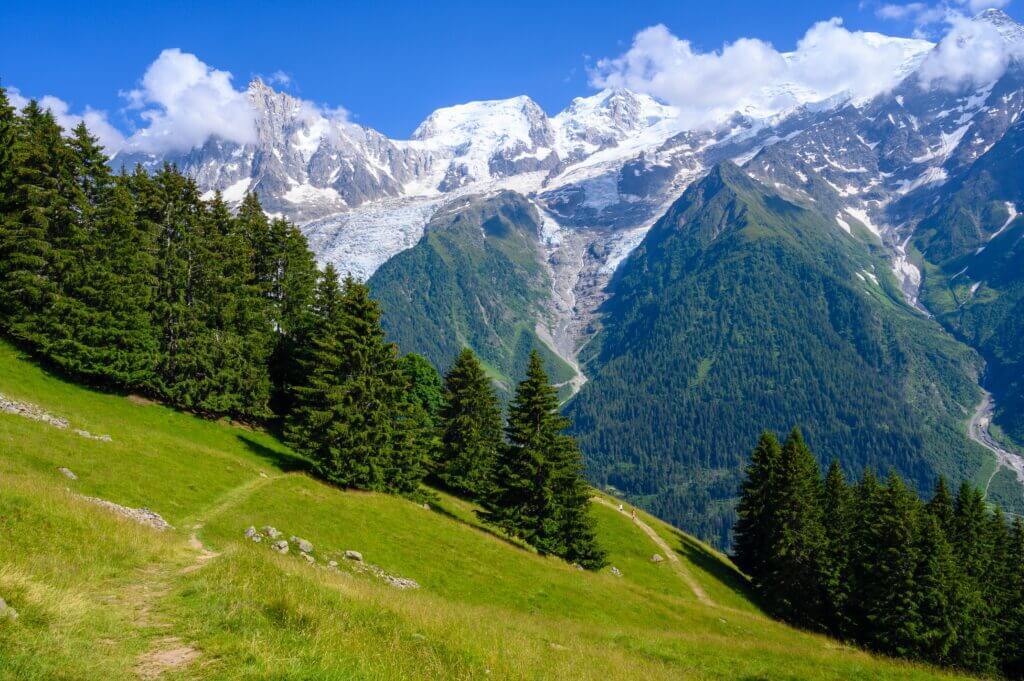
Chamonix is a must-visit destination, not least for the Aiguille du Midi peak, claiming an elevation of 3,842 metres and commanding unparalleled views of Mont Blanc and the Glacier des Bossons. A 20-minute cable car ride securing passage above the high-mountain forestry ushers visitors from Chamonix’s centre to the Aiguille du Midi.
The Panoramic Mont-Blanc gondola offers an alternative route to breathtaking scenery, its trajectory traversing ice falls and crevasses and affording viewpoints towards Pointe Helbronner in Italy.
Explore Annecy: A Fairy-Tale Town in the French Alps
Nestled beside a serene lake, with the majestic snow-crowned mountains as its backdrop, Annecy appears as a picturesque vision plucked right from a storybook. Elegant white swans effortlessly float amidst the slender canals of the Thiou River, emerging from the lake and coursing through the vintage part of the town.
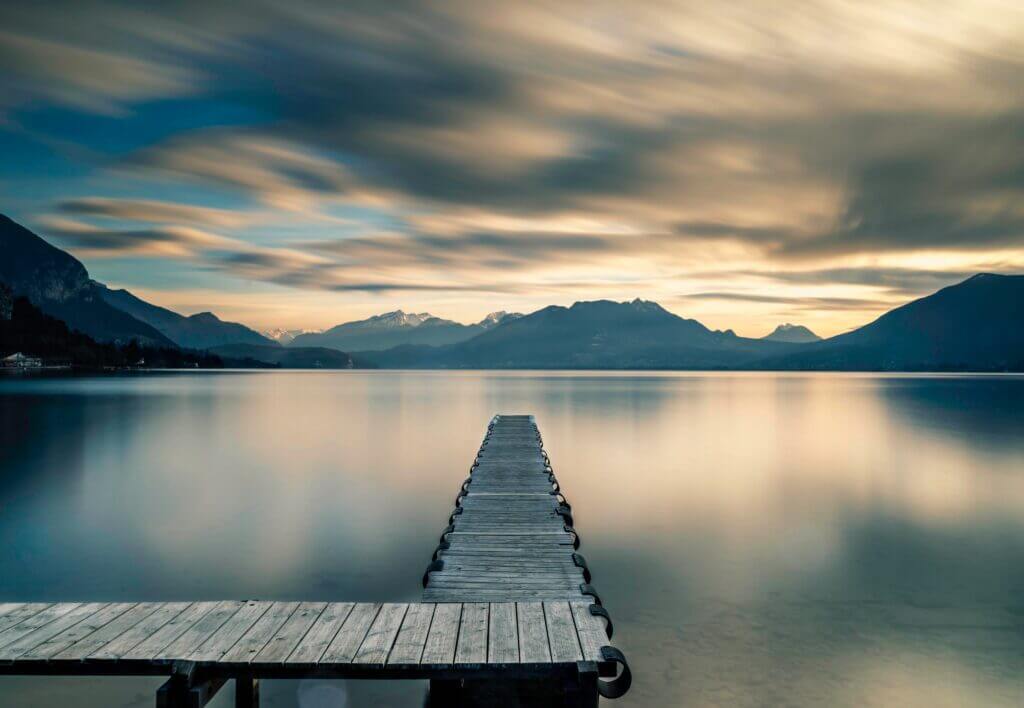
The historic hub of Annecy beguiles visitors with its captivating beauty and timeless allure. Numerous edifices merit appreciation, with many balconies festooned with vibrant geraniums. The winding flagstone pathways entreat a leisurely stroll, whilst the water channels dotted with petite footbridges amplify its fairytale charm.
Within this antique quarter, a unique site to amble is along Rue Sainte-Claire. This remarkable boulevard, adorned with arcade-styled buildings from the 16th to 18th centuries, now accommodates an array of boutiques and eateries.
Concealed amidst Annecy’s medieval streets exist numerous architectural marvels. Annecy boasts two illustrious churches, the 15th-century Eglise Saint-Maurice and the 16th-century Cathédrale Saint-Pierre.
The 12th-century Palais de l’Île, embedded on an islet within the Canal du Thiou, is a must-see within the old town. Originally a jail, this edifice later functioned as the Palace of Justice. Currently, the Palais de l’Isle hosts various exhibits manifesting regional architecture and past accounts.
Another esteemed attraction in Annecy is the Château d’Annecy, tracing back to the 13th century, previously inhabited by the Counts of Geneva. Today, The castle is a museum featuring local history, medieval sculptures, landscape artworks, and modern art.
Animation enthusiasts should take a moment to stroll from the castle towards the Musée du Film d’Animation, showcasing exhibits detailing the process of animated film production.
When the climate tempers, the Lac d’Annecy attracts many holidaymakers. Come springtime, the lake teems with life, and potted florals enhance the charm of the lakeside walkway.
Visitors can saunter along the lake shores running alongside the Avenue d’Albigny, enveloped by plane trees and equipped with a pathway welcoming bikers and pedestrians. This route stretches approximately one kilometre along the lake, culminating at the Parc Charles-Bosson, a waterfront park offering benches near the waterside and an expansive verdant spread idyllic for picnics.
The Impérial Palace, a legendary Belle Époque hotel, is situated just beyond the Parc Charles-Bosson on Avenue d’Albigny, set in magnificent verdant scenery with a rose garden. This four-star hotel flaunts contemporary-style rooms, elegant lounges, a gourmet restaurant, a wellness centre, a spa, and concierge amenities.
Alpine Elegance: Aix-les-Bains and Its Restorative Charm
Nestled on the eastern shores of Lac du Bourget, France’s grandest natural lake, Aix-les-Bains gleams as a prestigious Savoy resort in the heart of the Auvergne-Rhône-Alpes region. Historically, this idyllic town played host to luminaries and royalty, including the renowned American author Mark Twain. The pristine glacial waters of Lac du Bourget provide a serene backdrop, best experienced with a leisurely stroll along the tree-lined Esplanade du Lac. From here, one can catch a glimpse of the rugged alpine vistas, notably the Hautecombe Abbey, the final resting place for numerous members of the House of Savoy. Mont Revard stands as a testament to the region’s limestone cliffs, offering an expansive network of cross-country ski routes during winter. Come summer; this challenging terrain is taken up by expert cyclists having witnessed numerous Tour de France contests. The panoramic views atop, they say, are truly breathtaking.
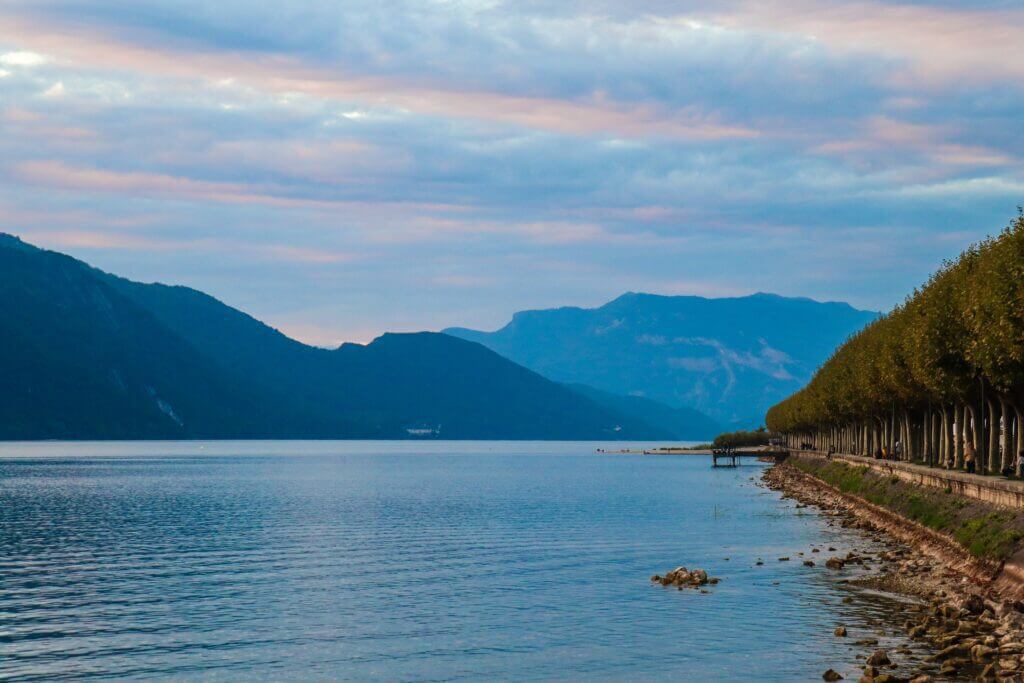
For a quieter retreat, one can indulge in the Musée Faure’s treasures, boasting of Rodin’s exquisite works and a selection of Impressionist masterpieces. Alternatively, immerse in the rejuvenating embrace of the town’s famed thermal baths. The architectural splendour of Aix-les-Bains seamlessly merges eras, from awe-inspiring Roman ruins, such as the Temple of Diana, to the opulent Belle Époque edifices like the Casino Grand Cercle and the elegant Le Mirabeau hotel.
Situated amidst the majestic alpine contours near Lac du Bourget, Aix-les-Bains stands distinguished as a premier spa retreat. Its pastoral surroundings, awe-inspiring vistas, and tranquil milieu champion its stature as a haven for wellness.
The town’s mineral-rich hot springs, reputed for their healing properties, have been sought after since the days of the Romans, with remnants like the Arch of Campanus standing testament to this legacy.
Modern indulgence meets tradition at the Marina Adelphia Spa and Hotel, where state-of-the-art wellness facilities coexist with an opulent spa complete with a sauna, Jacuzzi, and hammam. The hotel also prides itself on its gourmet restaurant serving delectable French fare. The Domaine de Marlioz offers a similar blend of luxury and wellness, encompassing two hotels and boasting therapeutic baths set amidst a tranquil park, its canopy provided by ancient trees. For a truly therapeutic experience, Thermes Chevalley, set against a picturesque mountainous backdrop, provides a range of treatments in pools filled with therapeutic thermal waters known to alleviate a myriad of ailments.
Architecturally, Aix-les-Bains is a canvas of history, its skyline dominated by structures reminiscent of the Belle Époque’s elegance. The 15th-century Château des Marquis d’Aix, now serving as the Town Hall, showcases a splendid Renaissance staircase crafted from Roman masonry.
For aficionados of the arts, the Musée Faure, ensconced within a magnificent villa on Boulevard des Côtes, offers an enviable collection spanning Impressionist paintings, masterful Rodin sculptures, and exquisite faience ceramics.
Discovering Alpe d’Huez: A Sun-Kissed Resort Town in the French Alps
Elevated over 6,000 feet above sea level, Alpe d’Huez stands as a perennial resort town nestled within the French Alps. The resort town’s Pic Blanc glacier ascends almost to the height of 11,000 feet, with its grand spectacle accessible in both winter and summer months. Renowned for its lavish, sunlit slopes, Alpe d’Huez has been aptly dubbed the “Island of the Sun”, inviting skiers and snowboarders of various proficiencies to its warm embrace.
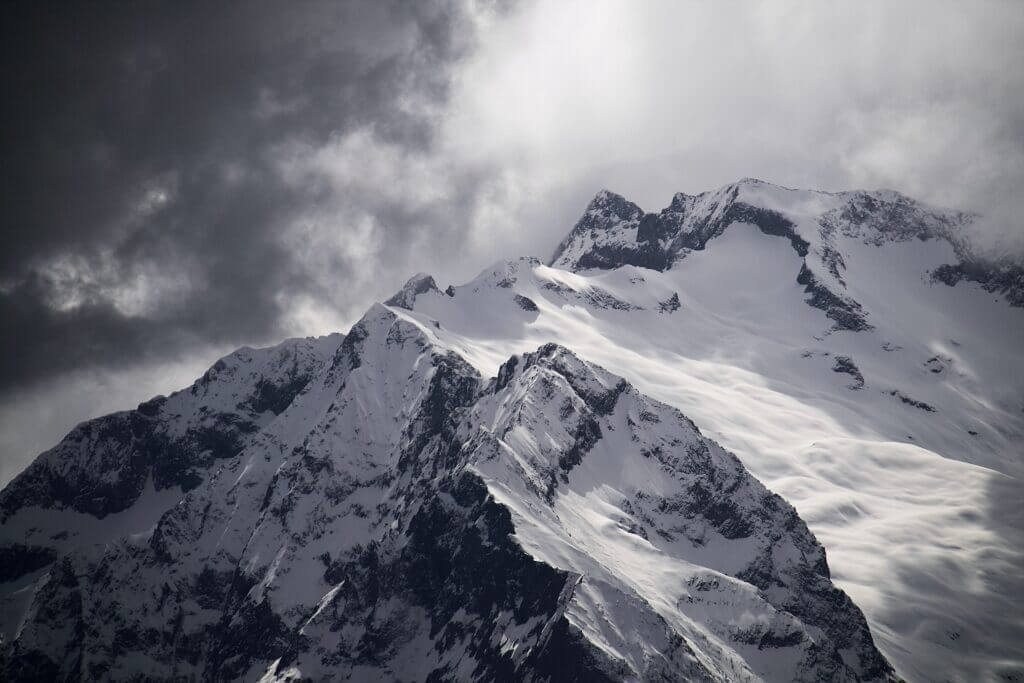
Here, tourists are encouraged to initiate their stay with a visit to the Grotte du Glace. This ice cave is located at the pinnacle of one of the ski lifts and boasts an array of striking ice sculptures. Throughout July and August, the lifts remain functional, permitting hikers and mountain bikers to exploit the 21 stimulating hairpin bends that routinely feature in the Tour de France. Moreover, these lifts facilitate access to the quaint Alpine hamlets of Vaujany and Oz en Oisans from Alpe d’Huez.
Whilst the local catering establishments are duly known for their cream and cheese gastronomic offerings, the freshly refurbished Le Génépi provides diners with a menu inspired by local produce. Previous guests hail this restaurant as a refreshing gust of culinary brilliance in the French Alps. The diverse range of dishes served alongside panoramic terrace views creates a unique dining experience in this Alpine resort town.
Exploring the Rich Heritage of Chablais: A UNESCO Global Geopark in the French Alps
The Chablais UNESCO Global Geopark, a mountainous region poised on the border of France and Switzerland, encompasses over 60 French municipalities. Signifying ‘head of the lake,’ Chablais’ name draws on the proximity of Lake Geneva. Its UNESCO status celebrates not only the region’s extensive geological history spanning millions of years but also its vibrant cultural heritage, including the local traditions of cheese and wine crafting. The designation of ‘geopark’ is intended to illuminate the enduring connection between the local populace and the natural landscape– a relationship that is keenly felt throughout the French Alps in the region’s pervasive attention to water resources and natural springs.
UNESCO offers a virtual map for tourists highlighting various destinations within the Chablais. This includes various abbeys, castles, and museums worth exploring to enrich one’s Alpine journey. A particularly remarkable institution is the Musée de la Musique Mécanique (Mechanical Music Museum) situated in Les Gets. The vast ensemble of instruments displayed invariably takes visitors aback; an ensemble replete with eccentric and vintage mechanisms guaranteed to captivate for hours on end.
Exploring Évian-les-Bains: A Quintessential Spa Town in the French Alps
Situated within the charming surrounds of the Chablais UNESCO Global Geopark lies Évian-les-Bains, a town steeped in heritage and famous for its alluring mineral springs. Nestled upon the southern bank of the serene Lake Geneva, this quintessentially French spa town is a haven of beauty and tranquillity.
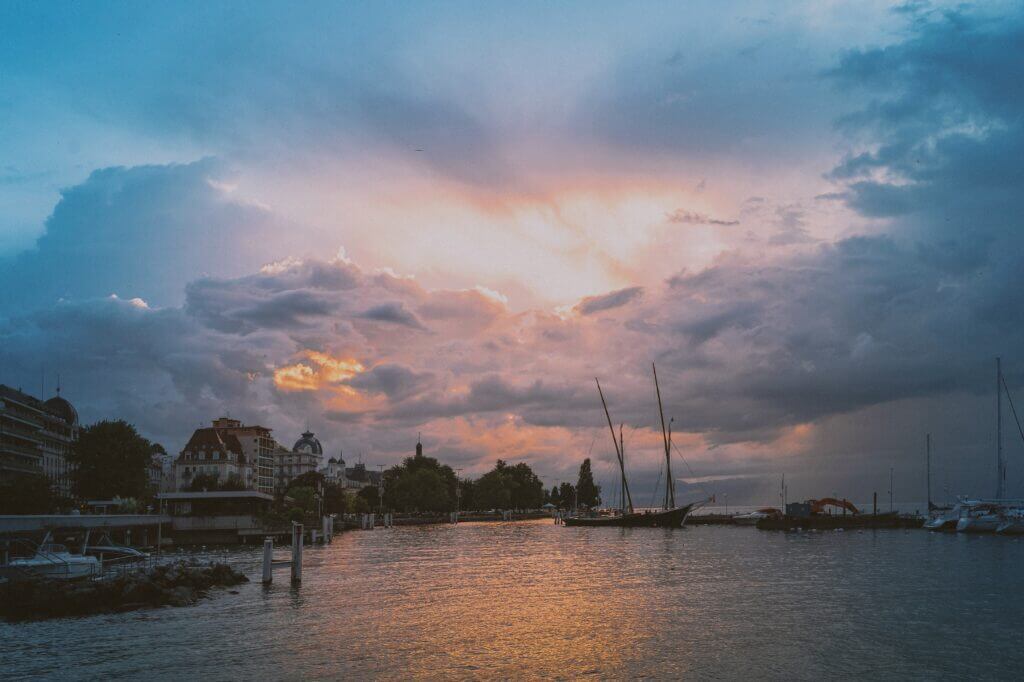
Synonymous with the globally renowned bottled water company, Évian-les-Bains’s appeal extends beyond its health-giving waters. A favoured retreat of the illustrious Lumière family, pioneers of modern cinema, the town is the proud home of their summer residence, Villa Lumière. This opulent abode currently serves as a hotel and invites guests for self-guided tours during the weekdays.
Stepping further back in time, the town’s neoclassical-style theatre, constructed in 1883, is a testament to the artistic expertise of one of Charles Garnier’s pupils. Garnier is revered for his architectural design of the Opéra Garnier in Paris.
The town’s rich past is also embodied in the grand Palais Lumière. Serving as a site for thermal baths in the dawn of the 20th century, its grand halls now host contemporary art and cultural exhibitions.
Évian-les-Bains’s appeal is not purely historical. Amidst the gently lapping waves of Lake Geneva sit the Pré Curieux water gardens, a singular lakeside habitat. Available to visitors via a solar-powered boat tour from May through October, this site blends scientific research with natural beauty.
For those visiting during the festive season, the Le Fabuleux Village des Flottins offers a magical gallery of creatures sculpted from driftwood, illuminated by twinkling light displays. This enchanting festival provides an enriching and captivating winter experience, complete with stalls serving fragrant vin chaud (hot mulled wine) and delicious pancakes.
Finally, a visit to this captivating French Alps destination would be incomplete without indulging in a Michelin-starred meal at the luxurious restaurant Les Fresques. Whether bathed in summer’s glow or enveloped in winter’s chill, Évian-les-Bains offers an unforgettable retreat.
Exploring Courchevel: A Premier Ski Resort
Renowned as a skier’s paradise, Courchevel boasts a spread-out resort encompassing six quaint villages in close proximity to Vanoise National Park, France’s inaugural national park. Nestled in the French Alps, this ski haven forms part of the illustrious Les Trois Vallées (the Three Valleys), acclaimed as the largest interconnected ski zone globally. Over 100 diverse ski tracks – from gentle slopes to challenging moguls – cater to skiers and snowboarders of all skill ranges.
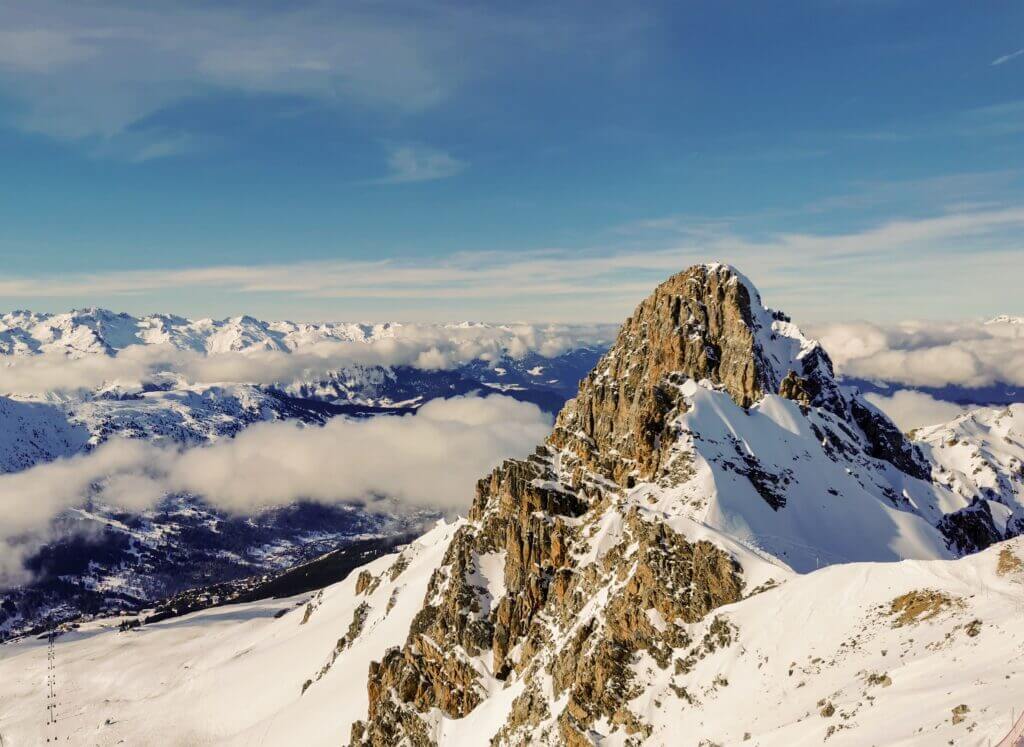
For those captivated by the allure of boundless off-piste territories, the neighbouring Val Thorens resort presents a landscape worthy of exploration. In contrast, families will find Méribel, another adjacent resort within the Les Trois Vallées, perfect in its provision of family-friendly features and amenities.
The charm of skiing culture isn’t limited to the slopes; it extends to the après-ski experiences, too, with Courchevel offering an array of enticing options. Le Tremplin, a bustling restaurant, offers a delectable culinary experience, whilst the Copiña Courchevel bar exudes an air of sophistication, serving a selection of tapas, beers, wines and cocktails. Guests have lauded the establishment’s convivial staff, exquisite beverages and vibrant atmosphere, with some even revelling in live music performances. The overwhelming appeal and ambience have ensured guest loyalty, as they find themselves returning to Copiña Courchevel time and time again.
Exploring the Serre Chevalier Valley: Skiing, Soaking and Sightseeing
Situated within France’s Haute-Alpes department lies the valley and ski resort of Serre Chevalier, comprising four unique communes. This location, favoured for its year-round abundance of sunshine, is nestled within the Guisane River valley, flanked by the majestic Cerces mountain range and the esteemed Écrins National Park.
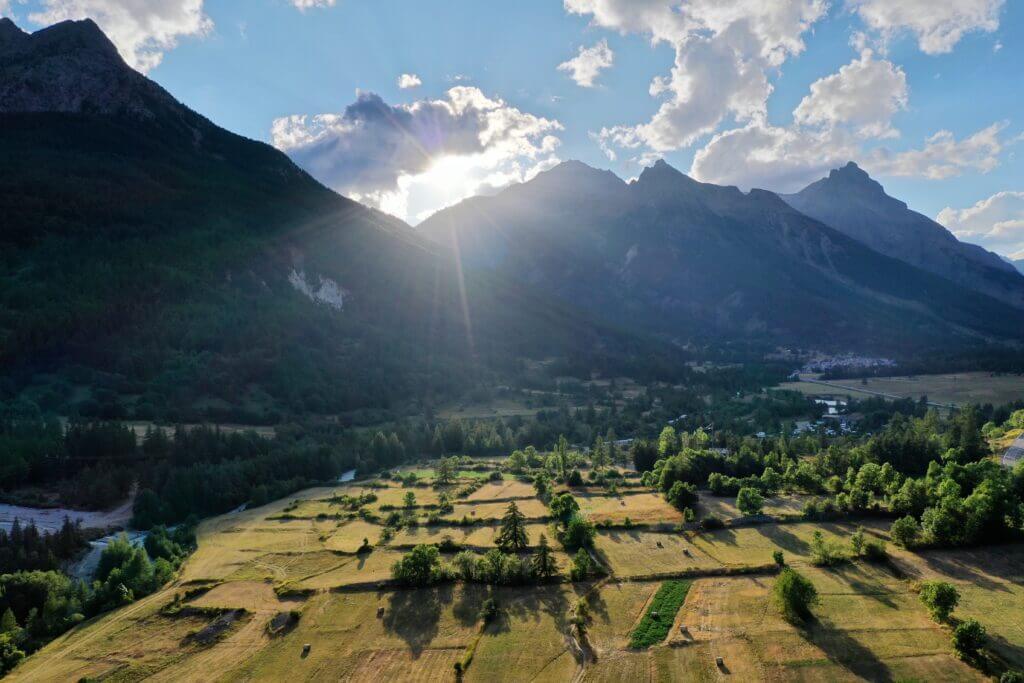
Among these communes is the unique Le Monêtier-les-Bains, a historical Roman settlement characterised by its rejuvenating thermal baths — operational from May through to December. Although the popularity of Les Grands Bains du Monêtier means they can become crowded, indulging in a soak is an experience certainly not to be missed, particularly after a day of exhausting hiking or skiing.
Briançon, another of these remarkable communes, enjoys recognition as a UNESCO World Heritage Site and possesses a rich tapestry of history for exploration. Ranking as one of Europe’s loftiest towns, its altitude surpasses 4,300 feet. Visitors to the peak of Serre Chevalier are rewarded with an awe-inspiring panorama of Écrins from a dizzying height of 3,600 feet, best enjoyed during a summer descent on the thrilling zip line.
For families travelling with younger members, children age 4 to 12 will find excitement in the valley’s sky-high Marmot Camp — an alpine-inspired wooden playground named after the local alpine squirrel-like marmot.
Val d’Isère: A Vibrant Skiing Resort
Throughout the year, the French ski resort town of Val d’Isère, which is located near the Italian border, upholds a lively atmosphere due to various festivals. The town is a buzz in the summer with an array of sporting and cultural events, such as races and celebrations, which Captivate both the locals and tourists.
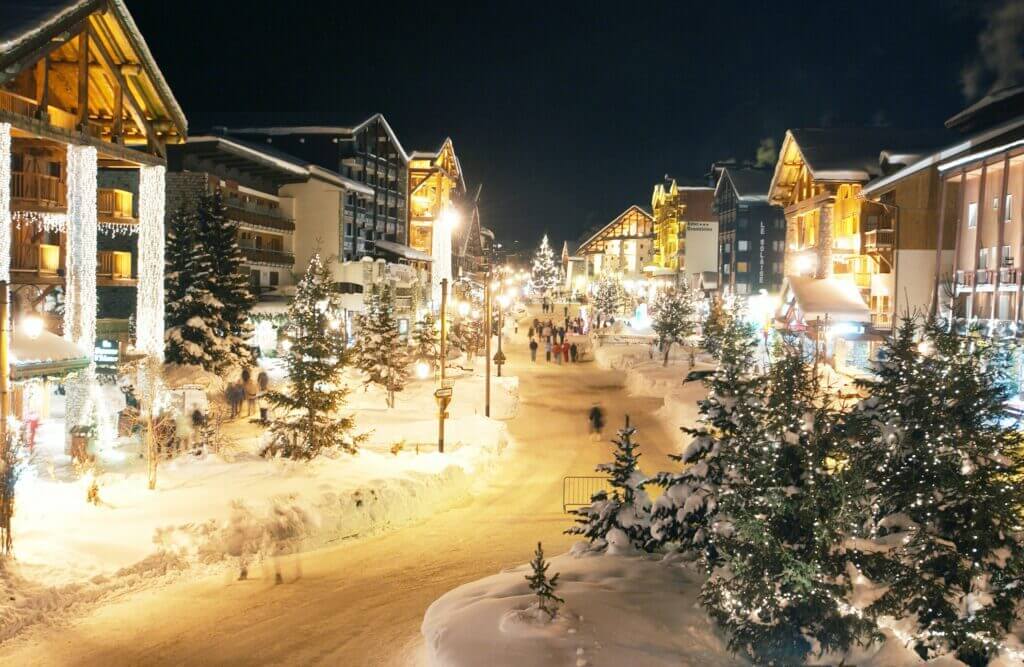
Acclaimed as one of the prime hosts of FIS Alpine Ski World Cup competitions, Val d’Isère is famous for its challenging off-piste and high-level difficulty skiing. However, the facility is also impeccable for beginners with its array of instructors catering to all ability levels, reasonably priced ski passes, and a skiing experience described by visitors as effortless and accessible. The town also takes pride in its fantastic après-ski culture with the awe-inspiring lakeside Bar de l’Ouillette serving crepes and the prominent Les 3 Caves of La Folie Douce, which houses a high-altitude wine cellar, as well as distinct caves devoted to cheese and cigars.
Val d’Isère has remained a preferred skiing destination due to its extensive terrain accessible via many ski lifts and cable cars. Nestled in the Tarentaise Mountains, the sprawling Tignes-Val d’Isère ski resort extends from elevations of 1,550 metres to 3,500 metres.
This vast ski area offers a myriad of options, both on and off-piste, allowing for a unique skiing path each time. The area boasts 163 ski runs covering mountainsides over a range of 300 kilometres.
The village of Val d’Isère, centred around a Baroque church, retains the charm of a traditional alpine settlement. As the quaint hamlet has developed into a modern resort, it boasts a vibrant après-ski atmosphere and a range of dining options. These include casual establishments serving robust Savoyard meals to Michelin-starred restaurants like La Table de l’Ours and L’Atelier d’Edmond.
During the summer, Val d’Isère lures in tourists with its stunning mountain landscape and array of outdoor activities like hiking, horse riding, mountain biking and climbing. The area, ripe for nature walks, offers idyllic scenery adorned with wildflowers and birdlife.
Exploring Saint-Gervais-les-Bains: A Prime Destination in the French Alps
Located approximately 40 miles from Geneva, Saint-Gervais-les-Bains nestles in the shadow of Mont Blanc and other majestic peaks. This quaint French town is a convenient gateway for excursions to Chamonix and a starting point for extended journeys to the likes of Lausanne in Switzerland or Turin in Italy. Not to be overshadowed by its neighbours, Saint-Gervais holds its own as a prime destination in the French Alps, boasting an array of delightful restaurants and the invigorating mountain air.
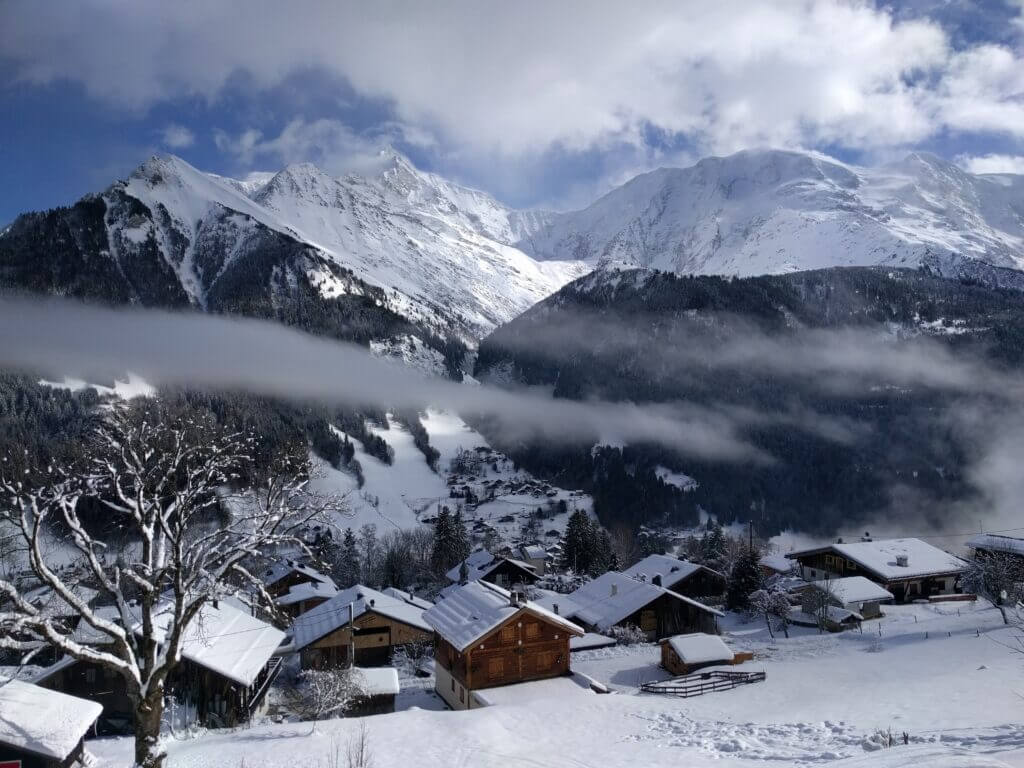
A notable highlight is the Mont Blanc tramway, which offers breathtaking views on its 70-minute journey. A brief 30-minute stroll from its pinnacle brings you to the captivating Bionnassay Glacier. Additionally, one can embark on a cable car journey from the town’s western region to ascend Le Bettex, a charming mountainous village. Whilst there, a visit to La Flèche d’Or is a must – a hotel and eatery renowned for its traditional Savoie cuisine, crafted using locally-sourced ingredients. Further on, the cable car can transport you to Mont d’Arbois, which promises unparalleled vistas. Upon returning to Saint-Gervais, the Les Bains du Mont Blanc stands out as a premium thermal spa, harnessing the area’s naturally heated waters for a luxurious experience.
Set against the backdrop of the Alpine foothills, Saint-Gervais has long been celebrated, since the Belle Époque era, as one of Savoy’s premier spa towns. This locale is a haven for those seeking a tranquil retreat amidst spectacular mountain landscapes, complemented by rejuvenating thermal baths. Numerous establishments in Saint-Gervais-les-Bains provide exclusive spa amenities.
The opulent Armancette Hotel offers its guests a lavish stay, whether in sophisticated rooms, elegant suites, or well-appointed chalets. As a five-star establishment, it boasts a top-tier spa complete with an indoor-outdoor pool, a trio of Jacuzzis, and both sauna and steam room facilities. Furthermore, guests can relax on the hotel’s terrace, which offers a commanding view of Mont Blanc.
Furthermore, when winter descends, Saint-Gervais-les-Bains transforms into a snowy wonderland, interconnected by a series of cableways to the renowned ski domains of Megève and Chamonix.
Exploring the Biodiversity and History of Mercantour National Park in the Southern French Alps
Encompassing the utmost southeast corner of France, Provence-Alpes-Côte d’Azur is home to the esteemed French Riviera (Côte d’Azur) and a section of the majestic Alps. Nestled within the Alpes-Maritimes and Alpes-de-Haute-Provence departments, one discovers the exalted Mercantour National Park, a mere 30 miles from the lush city of Nice. This magnificent national park, spreading over more than 250 square miles, comprises multiple valleys, such as the beguiling Ubaye Valley.

This sanctuary of untouched wilderness is a marvel of biodiversity, heralding more than 2,000 varieties of blooming flora and thousands of Bronze Age petroglyphs. Nearly 400 miles of well-maintained park trails open the gate to the richness of this secluded natural haven in the southern French Alps. Visitors are invited to partake in memorable activities such as kayaking in the mesmerising turquoise waters of the Verdon River through the dramatic Verdon Gorge or hiking along the precipitous canyon rim.
The wild and untouched landscapes of the Ubaye Valley beckon lovers of the outdoors, leading them towards the charming mountain town of Barcelonnette, where opportunities for hiking, canoeing, and skiing abound.
Exploring Grenoble: The 2022 European Green Capital in the French Alps
Renowned as the European Green Capital for 2022, Grenoble, France, symbolises an eco-conscious choice for a holiday in the French Alps. Harmonising the functionality of a bustling metropolis with the awe-inspiring grandeur of the nearby mountains, the city offers an intriguing juxtaposition of cosmopolitan delights and scenic wonders like the proximate Chartreuse Regional Nature Park. Symbolic of its ‘green’ acclaim, the esteemed Grande Chartreuse monastery— located within the Chartreuse mountain range, slightly north of Grenoble—is home to Carthusian monks, the custodians of the classified recipe of the green Chartreuse liqueur. The monastery is not open for public visitation, but the local Grand Chartreuse Museum offers displays concerning the Carthusian Order.
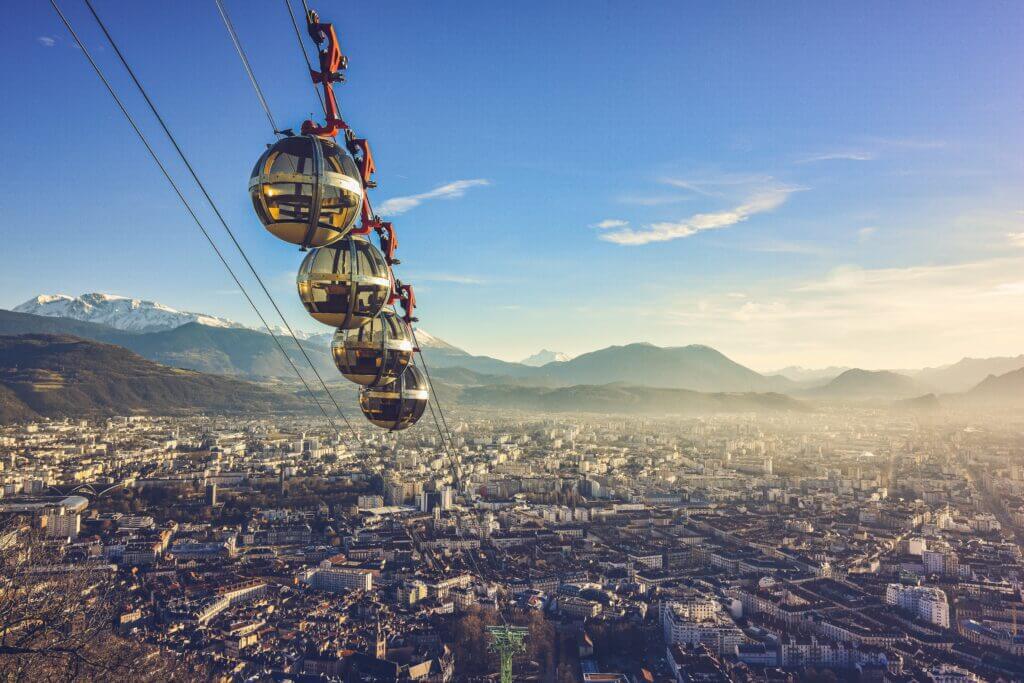
Within the vicinity, the Belledonne mountain range is famed for its spectacular views, including stunningly ethereal sunsets. A haven for the intrepid, an array of activities awaits, from paragliding to hiking, skiing to snowshoeing during the wintery months. Nestled in Grenoble city centre, the historic La Bastille fortress offers panoramic views of the city. A cable car service operates from the centre, and uphill hikes to the top are welcomed. Nestling approximately 10 miles south of Grenoble, the French gardens and chateau of the Domaine de Vizille exude such elegance and grace that their housing of the Museum of the French Revolution may come as a surprise. A walk-through of the chateau’s galleries beautifully melds art with historical artefacts. Children will delight in the sight of swans, ducks, deer and other wildlife freely wandering the sanctuary of the grounds.
Former capital of the Dauphiné region, Grenoble is nestled in a basin of the Isère Valley, encased by majestic mountains that tower up to 3,000 meters. The cityscape is dominated by Fort Rabot and the Fort de la Bastille, situated on the ridges of the Mont Rachais range.
Historical landmarks within Grenoble’s ‘Vieille Ville’ include the awe-inspiring Palais du Parlement du Dauphiné (Hall of Justice of the Estates of the Dauphiné), an architectural masterpiece that skilfully blends flamboyant Gothic and early Renaissance styles; along with the equally captivating ‘Musée de l’Ancien Évêché’, a 13th-century Episcopal palace now transformed into a museum documenting Grenoble’s rich history.
Widely regarded as one of the country’s best fine arts museums, the Grenoble Museum houses an exquisite collection of works, including old masters like Rubens, George de La Tour and Philippe de Champaigne, in addition to 19th-century virtuosos such as Delacroix and Monet. Modern masterpieces by Picasso, Matisse, and Léger also enhance the collection.
Grenoble is enveloped by alluring natural beauty and verdant green spaces, complementing the city’s impressive cultural offerings. The Jardin des Dauphins, a sumptuous 30-hectare haven of terraced gardens, offers unparalleled, elevated vistas of the city. The shaded pedestrian paths and intricate stairways woven into the landscape make this park a sublime haven for tranquil exploration.
La Clusaz: A Gastronomic Adventure
Resplendent with wine and cheese, some of the finest ones can savour, France is a cornucopia of culinary delights. One such commune revelling in these French essentials is La Clusaz, nestling approximately 40 miles west of Chamonix, within the heartland of the Auvergne-Rhône-Alpes region. They host a jubilant annual celebration known as the Fête du Reblochon – a festival dedicated to cheese and the revered local farmers who curate it. The revelries encompass demonstrations, tastings, a grand procession, and plenty of traditional dancing, collectively fostering a spirit of mirth and camaraderie. The local gastronomic panorama also includes delectable chocolate truffles, crisp white vermouth along with an array of distinctive wine cultivars.
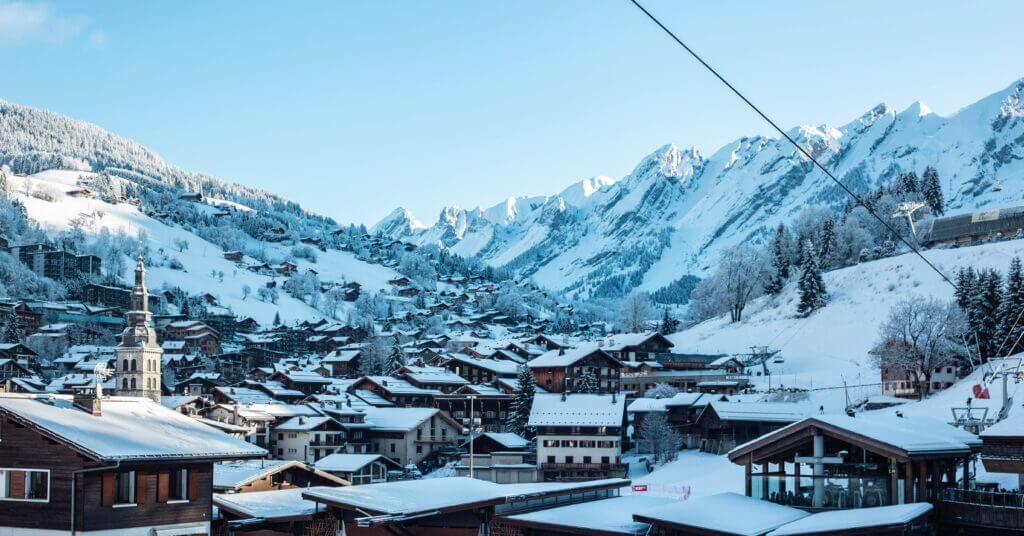
La Clusaz, as recent visitors reveal, is a charming, petite ski town brimming with inviting restaurants and snug bars to replenish oneself. Post indulging in these gastronomic extravagances, a visit to Col des Aravis can assist one in counterbalancing the caloric intake from ample cheese consumption. The hiking trails here offer panoramic views emblematic of the French Alps, including the snow-draped Mont Blanc, dense pine tree forests, alpine flowers, a glacial lake, and even a quaint chapel. The La Clusaz experience is amplified for thrill-seekers with a unique sport named equestrian skijoring. Testing one’s nerve, this distinct winter activity involves gliding on skis whilst being towed by a horse through the frost-laden landscape.
Exploring the Attractions of Megève
Amid the resplendent spectacle of the French Alps, the genteel atmosphere of Megève sets a formidable stage for the world-renowned Tour de France, a rare hosting honour it has been privy to twice. Megève’s international appeal as an events site extends further to the illustrious annual equestrian spectacle, Jumping International de Megève. It pulls in captivated audiences from the four corners of the globe as well as from its home nation of France.
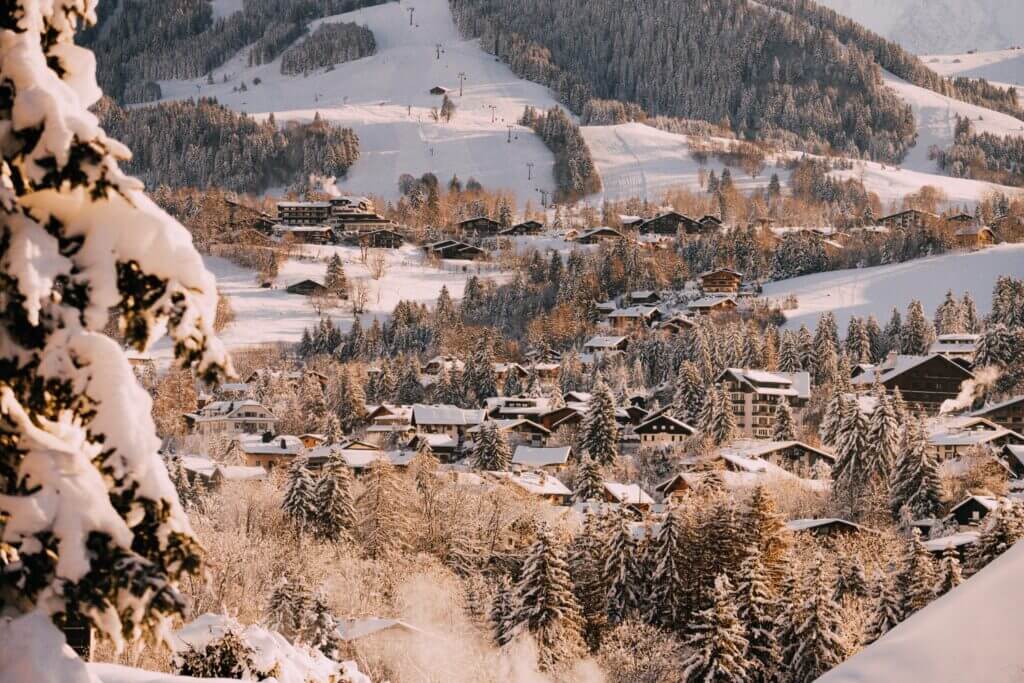
Yet, Megève isn’t merely a hub for elite sporting events. Visitors to the town are presented with an array of sensory delights, most notably from its superb gastronomy sector. The prized restaurant La Dame de Pic – Le 1920, overseen by Michelin-decorated chef Anne-Sophie Pic, the leading female chef distinguished with Michelin stars, resides within the prestigious Four Seasons Hotel Megève.
Not to be eclipsed by its culinary prowess, Megève also boasts a compelling retail landscape. It ranges from the refined, such as luxurious antique furnishings, through to the rustic charm of local produce and culminates in the contemporary appeal of sought-after fashion labels. The urbane can pause from their retail reveries at Le Georges, an elegant sanctuary nestled within the Hotel Mont Blanc. Here, visitors may savour the fragrant tranquillity of afternoon tea or, when the light fades, revel in the delightful sparkle of evening Champagne.
Megève readily extends a warm welcome to families, making it an ideal destination for a holistic family holiday. Youngsters in the family can benefit from a plethora of sports courses and diverse cultural workshops, presenting a lively enrichment program. The charm and sophistication of Megève are undeniably magnetic, making it a destination of choice for the discerning traveller.
Exploring the Vercors: A Natural Paradise in the French Alps
Situated within the Dauphiné region, nestled between the Rhône Valley and the Route d’Hiver des Alpes, lies the coveted Vercors range. These forest-cloaked hills extend to a towering height of 2,346 metres at the Grand Veymont, and are interspersed with deeply carved valleys and breathtaking gorges.
The Vercors Natural Park boasts an array of well-maintained routes and trails, enabling the exploration of this verdant landscape either on foot or astride a horse. During the frosty season, a wide variety of winter sports can be enjoyed amid splendid facilities. Circumnavigating the Vercors is strongly advised, as it allows one to appreciate the unique scenery characteristic of this region fully.
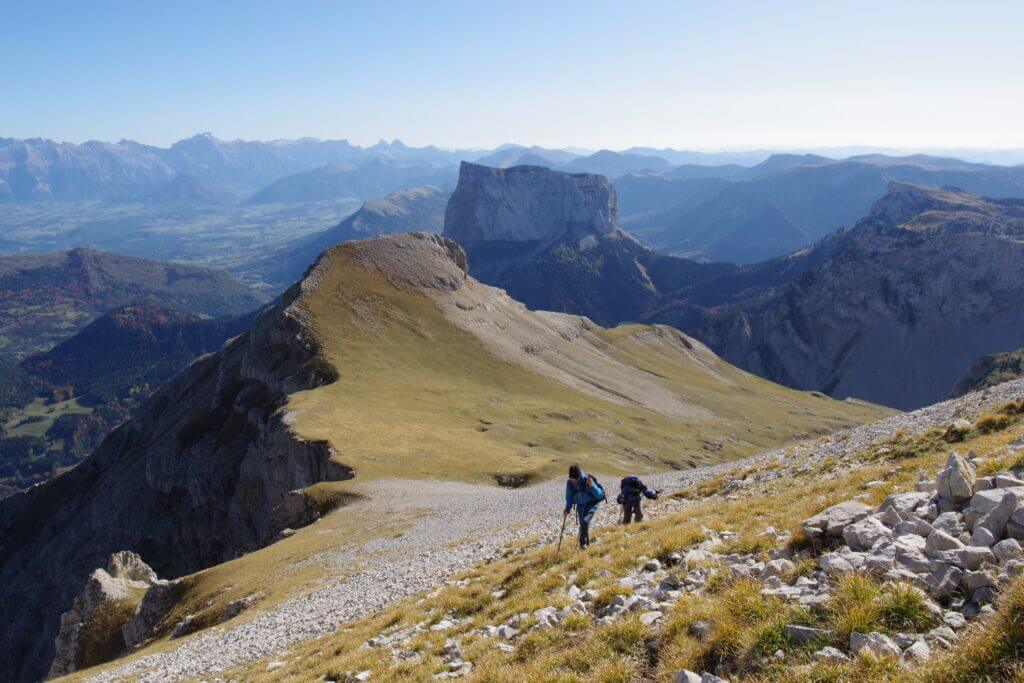
Traversing the Combe Laval, a mountainous trail put in place in 1897, was originally established for the transfer of timber from the Forêt de Lente to Saint-Jean-en-Royans. Starting from the wood-laden Col de la Machine and descending towards Saint-Jean, this stretch of the road exhibits stunning panoramic views of the land below.
Past the village of Villard-de-Lans, the highway winds its way into the Bourne Valley, which gradually tapers into the Gorges de la Bourne. The journey continues through towering tunnels and graceful bridges, leading towards the quaint township of Pont-en-Royans. From there, the road winds alongside the Vernaison Valley and through the picturesque Vernaison gorges, gradually ascending through numerous bends before reaching the imposing Grands Goulets gorge.
Exploring Yvoire: A Picturesque Village
Renowned as one of the most picturesque hamlets within France, Yvoire forms part of the Chablais UNESCO Global Geopark region, an assignment well-justified by its seven-century-long chronicle and its present-day allure. Traditional Alpine representation is remarkably manifest in this locale, gently cradled by Lake Geneva’s shores, attributing to its well-earned sobriquet, “gem of the lake”.
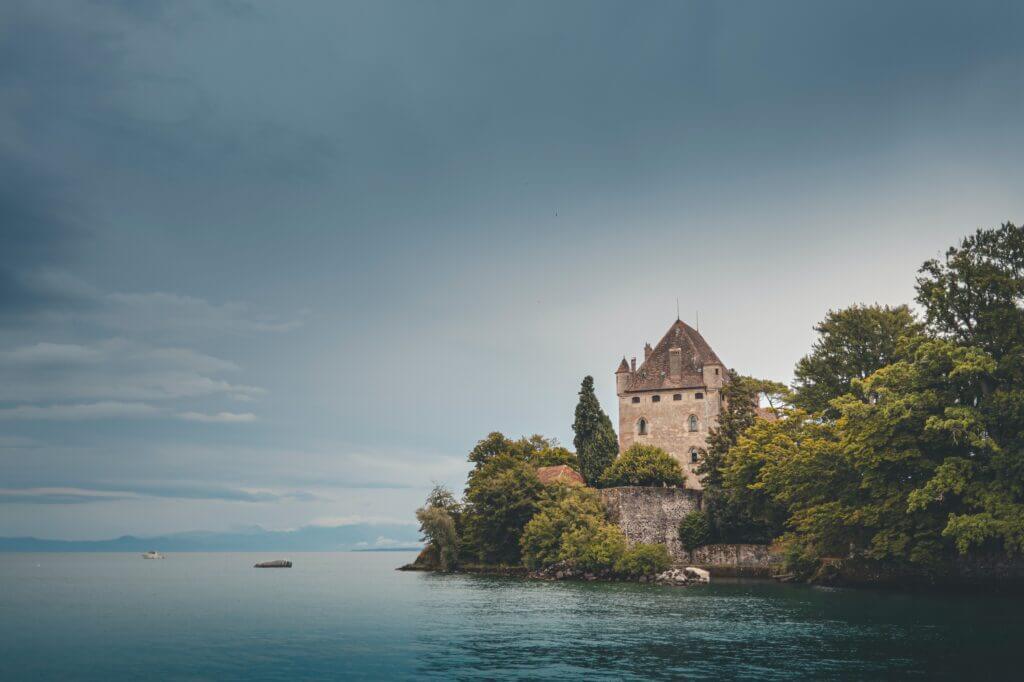
Erected in 1306, the Château d’Yvoire, a quintessential Yvoirian landmark, dominates the locale with its medieval grandeur. Whilst public access is restricted, the castle presents an irresistible photo opportunity for any visitor. On the other hand, the Jardin des Cinq Sens, or Garden of the Five Senses, seduces tourists with its diverse gardens, stimulating exploration through not only sight but touch and smell alike. This hidden paradise, once discovered by visitors, promises a sensory delight.
The allure of this idyllic French Alpine retreat extends beyond its historical remnants. Yvoire’s lanes are reserved exclusively for pedestrian ambling, offering a delightful opportunity for unhindered meandering. The village’s aesthetic grandeur is further augmented by an abundance of florals, leading to its alternative moniker, the “French flower village”. In Yvoire, romance permeates every cobbled street and leafy grove, making it a favoured destination amongst those seeking adventure underlined by charm.
Exploring Cirque du Fer-à-Cheval: A Mountain Reserve and Alpine Village in the French Alps
Imbued with the grandeur of a limestone mountain, carved over time by receding glaciers into an arresting circular formation, the Cirque du Fer-à-Cheval presents an awe-inspiring spectacle. Unmarred by human hand, this captivating nature reserve boasts an array of picturesque footpaths for serene ambles as well as challenging hikes. Patrons are captivated by its serene alpine atmosphere, fragrant with the scent of crisp pine trees, the quietude occasionally punctuated by the rush of a mountaintop waterfall cascading onto snow-laden peaks.
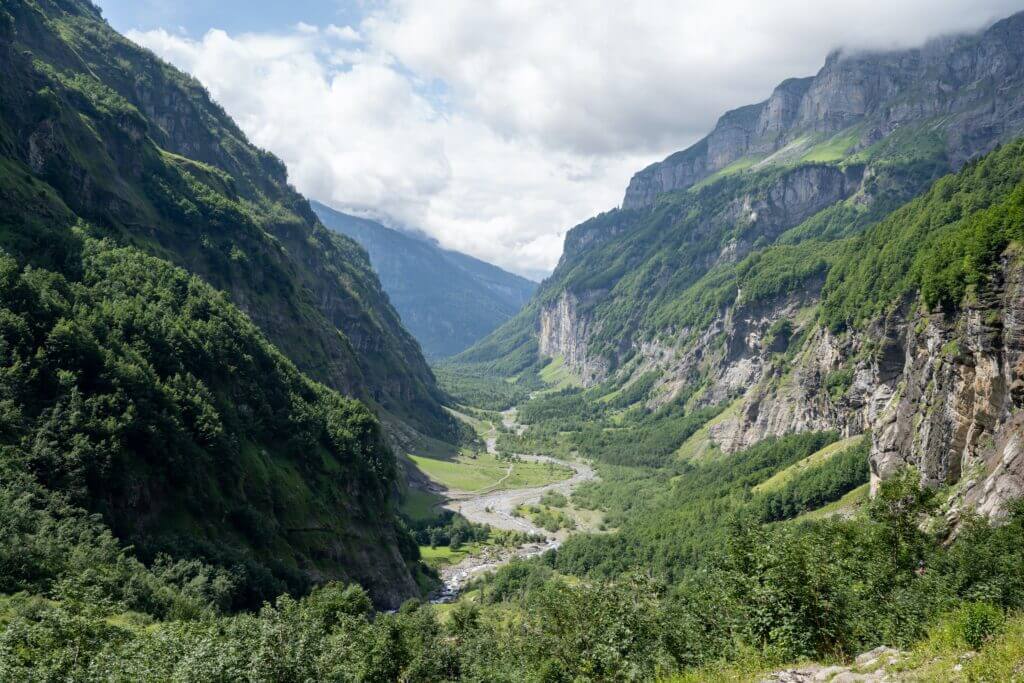
Nestled deep within this untamed territory resides the charming hamlet of Sixt-Fer-à-Cheval, recognised as one of France’s “Plus Beaux Villages” (Most Beautiful Villages). An amalgamation of 24 smaller hamlets, each one uniquely enveloped by the verdant splendour of the nature reserve, Sixt-Fer-à-Cheval is embellished further by the captivating “Cascade du Rouget” waterfall.
Distinctive for its quintessential alpine architecture of steeply pitched roofs and towering church steeples, Sixt-Fer-à-Cheval is steeped in history. The village is the home to the venerable Abbaye de Sixt-Fer-à-Cheval, an ancient abbey founded by Ponce de Faucigny in the 12th century and an adjoining 13th-century parish church. The church complex also features a verdant garden, inviting the public for quiet contemplations amidst nature.
A stone’s throw away from the hamlet, visitors can find a ski resort, an ostensible nod towards the alpine region’s love for winter sports. Quick access to a plethora of hiking trails and exhilarating outdoor activities such as mountain biking and fishing further amplifies the town’s appeal to enthusiasts of outdoor pursuits.
Exploring Thonon-les-Bains and Surrounding Countryside in the French Alps
Situated aloft the majestic Lake Geneva, Thonon-les-Bains serves as a coveted destination for spa enthusiasts, drawing substantial footfall in both the summer and winter months.
The 17th-century Château de Sonnaz, a vantage point of sheer beauty, is an irresistible allure with its breathtaking panoramic vistas of the Jura Mountains and the sparkling Lake Geneva. Sheltering the Chablais Museum, the Château provides an opportunity to delve into the heritage of the Chablais Mountains region with an assortment of intriguing exhibits.

Nestled 14 kilometres west of Thonon-les-Bains is the holiday resort of Excenevex, a gem on the shores of Lake Geneva. The resort lays claim to a vast natural sandy beach lined with lofty pines, which gives way to shallow, child-friendly waters, perfect for a swim. The shores of Excenevex are a haven for leisure activities such as boating, angling, and volleyball. Enhancing its appeal is an inviting children’s playground.
The medieval hamlet of Yvoire is accessible with a short additional journey. Deemed one of the “Most Beautiful Villages in France,” this enchanting lakeside settlement is home to a 14th-century fortress, complete with fortified walls and an immaculately arranged garden – recognised for its outstanding beauty as a “Jardin Remarquable”. Yvoire presents an effortlessly captivating experience steeped in history and nature.

